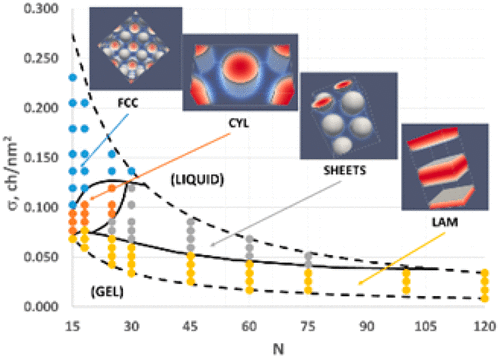当前位置:
X-MOL 学术
›
Macromolecules
›
论文详情
Our official English website, www.x-mol.net, welcomes your
feedback! (Note: you will need to create a separate account there.)
Modeling the Morphology and Phase Behavior of One-Component Polymer-Grafted Nanoparticle Systems
Macromolecules ( IF 5.1 ) Pub Date : 2017-11-17 00:00:00 , DOI: 10.1021/acs.macromol.7b01922 Valeriy V. Ginzburg 1
Macromolecules ( IF 5.1 ) Pub Date : 2017-11-17 00:00:00 , DOI: 10.1021/acs.macromol.7b01922 Valeriy V. Ginzburg 1
Affiliation

|
Polymer-grafted or “hairy” nanoparticles (HNP) represent an important and relatively new class of materials. Traditionally, polymers or oligomers were grafted onto the particle (silica, metal, or semiconductor) surface to improve the dispersion of particles in a polymer matrix. Recently, the scope of research has broadened substantially, as it was shown that such nanoparticles can form anisotropic structures ranging from self-assembled wires to sheets to networks. Furthermore, it has been demonstrated that one could make hybrid polymer–inorganic materials with HNPs alone, without using a separate matrix polymer. Such one-component hybrid materials are not prone to macroscopic phase separation and can, in principle, have a variety of interesting microphase-separated, anisotropic morphologies, similar to surfactants or block copolymers. Here, we develop a new self-consistent field theory describing the behavior of such one-component HNP systems and apply it to predict morphology as a function of the ligand molecular weight and grafting density. As in the case of block copolymers, we observe lamellar, cylindrical, and spherical morphologies and elucidate phase boundaries as a function of the core (nanoparticle) volume fraction and the ratio of the particle radius to the ligand radius of gyration. We also observe the formation of a novel phase, labeled as “sheets”, where the lamellar-like ordering of particle-rich and ligand-rich layers is additionally characterized by the hexagonal ordering of the particles within the particle-rich layer. Our theoretical approach can be easily extended to other HNPs, including those with mixed ligands and block copolymer ligands.
中文翻译:

单组分聚合物接枝纳米粒子系统的形态和相行为建模
聚合物接枝或“毛状”纳米颗粒(HNP)代表了重要且相对较新的一类材料。传统上,将聚合物或低聚物接枝到颗粒(二氧化硅,金属或半导体)表面上,以改善颗粒在聚合物基质中的分散性。近来,研究范围已大大扩展,因为已表明此类纳米颗粒可形成各向异性的结构,其范围从自组装线材到片材再到网络。此外,已经证明,无需使用单独的基质聚合物,就可以仅使用HNP制备杂化聚合物-无机材料。这样的单组分杂化材料不易于宏观相分离,并且原则上可以具有类似于表面活性剂或嵌段共聚物的各种令人感兴趣的微相分离的各向异性形态。这里,我们开发了一种新的自洽场论,描述了这种单组分HNP系统的行为,并将其应用于预测作为配体分子量和接枝密度的函数的形态。与嵌段共聚物一样,我们观察到层状,圆柱状和球形的形态,并阐明了作为核(纳米粒子)体积分数和粒子半径与配体回转半径之比的函数的相界。我们还观察到一个新相的形成,标记为“薄片”,其中富含颗粒和富含配体的层的层状排序另外以富含颗粒层内的颗粒的六角形排序为特征。我们的理论方法可以轻松扩展到其他HNP,包括具有混合配体和嵌段共聚物配体的HNP。
更新日期:2017-11-17
中文翻译:

单组分聚合物接枝纳米粒子系统的形态和相行为建模
聚合物接枝或“毛状”纳米颗粒(HNP)代表了重要且相对较新的一类材料。传统上,将聚合物或低聚物接枝到颗粒(二氧化硅,金属或半导体)表面上,以改善颗粒在聚合物基质中的分散性。近来,研究范围已大大扩展,因为已表明此类纳米颗粒可形成各向异性的结构,其范围从自组装线材到片材再到网络。此外,已经证明,无需使用单独的基质聚合物,就可以仅使用HNP制备杂化聚合物-无机材料。这样的单组分杂化材料不易于宏观相分离,并且原则上可以具有类似于表面活性剂或嵌段共聚物的各种令人感兴趣的微相分离的各向异性形态。这里,我们开发了一种新的自洽场论,描述了这种单组分HNP系统的行为,并将其应用于预测作为配体分子量和接枝密度的函数的形态。与嵌段共聚物一样,我们观察到层状,圆柱状和球形的形态,并阐明了作为核(纳米粒子)体积分数和粒子半径与配体回转半径之比的函数的相界。我们还观察到一个新相的形成,标记为“薄片”,其中富含颗粒和富含配体的层的层状排序另外以富含颗粒层内的颗粒的六角形排序为特征。我们的理论方法可以轻松扩展到其他HNP,包括具有混合配体和嵌段共聚物配体的HNP。











































 京公网安备 11010802027423号
京公网安备 11010802027423号